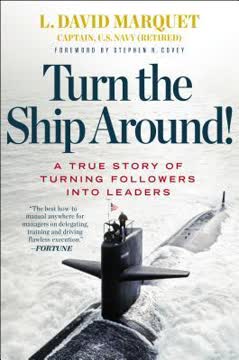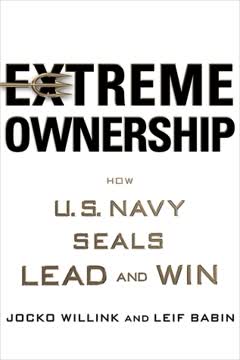Key Takeaways
1. Lead by Example: Actions Speak Louder Than Words
"If you want to change attitudes, start with changing behavior. In fact, the behavior comes first, then the attitudes."
Leadership is embodied. As a leader, your every action is scrutinized and sets the tone for your entire organization. It's not enough to simply give orders; you must live the values and behaviors you expect from your team. This means being the first to adopt new practices, taking responsibility for mistakes, and consistently demonstrating the work ethic and attitude you want to see.
Consistency is key. Your team will quickly spot any discrepancies between what you say and what you do. By aligning your actions with your words, you build trust and credibility. This might mean:
- Being the first to arrive and last to leave
- Participating in difficult or unpleasant tasks alongside your team
- Admitting your own mistakes and showing how to learn from them
- Treating everyone with respect, regardless of rank or position
2. Listen Aggressively: Tap Into Your Crew's Insights
"If you can't listen aggressively, if you can't pick up the good ideas your crew has, you're not going to be a very good leader."
Active listening is a superpower. As a leader, one of your most valuable skills is the ability to truly hear and understand your team. This goes beyond simply allowing people to speak; it means actively seeking out their ideas, concerns, and insights.
Create opportunities for input. Implement systems that encourage open communication:
- Regular one-on-one meetings with team members
- Anonymous suggestion boxes or feedback systems
- Town hall-style meetings where anyone can ask questions
- "Management by walking around" - informal conversations throughout the workplace
By consistently demonstrating that you value and act on input from all levels, you tap into the collective intelligence of your entire organization and foster a culture of innovation and engagement.
3. Communicate Purpose and Meaning: Unite Your Team
"The key to being a successful skipper is to see the ship through the eyes of the crew."
Shared vision creates motivation. People perform best when they understand how their work contributes to a larger purpose. As a leader, it's your job to clearly articulate the organization's mission and help each team member see their role in achieving it.
Make it personal and relevant. Effective communication of purpose involves:
- Regularly reinforcing the organization's overall mission
- Connecting individual tasks to broader goals
- Sharing success stories that demonstrate impact
- Encouraging team members to articulate how their work matters
By helping your team find meaning in their work, you tap into intrinsic motivation that goes far beyond simple compliance or the pursuit of rewards.
4. Create a Climate of Trust: Empower Your People
"Trust is like a bank account—you have got to keep making deposits if you want it to grow."
Trust is the foundation of high performance. When team members feel trusted, they're more likely to take initiative, share ideas, and go above and beyond. Building trust requires consistently demonstrating reliability, competence, and genuine care for your team's well-being.
Practical trust-building strategies:
- Delegate meaningful responsibilities, not just tasks
- Allow team members to make decisions within their areas of expertise
- Be transparent about challenges and decision-making processes
- Follow through on commitments and promises
- Admit your own mistakes and vulnerabilities
Remember that trust is reciprocal. By extending trust to your team, you create an environment where they're more likely to trust you and each other.
5. Look for Results, Not Salutes: Encourage Initiative
"If all you give are orders, then all you will get are order-takers."
Focus on outcomes, not process. Traditional hierarchies often prioritize adherence to protocol over actual results. By shifting your focus to outcomes, you empower your team to find creative solutions and take ownership of their work.
Encourage problem-solving at all levels:
- Clearly communicate desired outcomes, but allow flexibility in how they're achieved
- Reward initiative and innovative thinking, even when attempts fall short
- Create a "safe to fail" environment where calculated risks are encouraged
- Celebrate successes that come from unconventional approaches
By valuing results over rigid adherence to procedure, you foster a culture of continuous improvement and adaptability.
6. Take Calculated Risks: Push the Envelope
"Show me someone who has never made a mistake, and I will show you someone who is not doing anything to improve your organization."
Intelligent risk-taking drives progress. In a rapidly changing world, organizations that play it too safe are often left behind. As a leader, you must create an environment that encourages calculated risks and learns from both successes and failures.
Cultivate a risk-positive culture:
- Lead by example, taking well-considered risks yourself
- Analyze failures for lessons, not to assign blame
- Reward innovative thinking, even when ideas don't pan out
- Provide resources and support for promising new initiatives
Remember that the goal is not recklessness, but rather a balanced approach that weighs potential benefits against potential downsides.
7. Go Beyond Standard Procedure: Innovate Constantly
"Rules that made sense when they were written may well be obsolete. If so, make them extinct, too."
Challenge the status quo. Organizations often cling to outdated procedures out of habit or fear of change. As a leader, it's your responsibility to constantly question whether current methods are still the most effective.
Foster a culture of innovation:
- Regularly review and update standard operating procedures
- Encourage team members to suggest improvements to existing processes
- Create cross-functional teams to tackle complex problems
- Implement rapid prototyping and testing of new ideas
By consistently pushing beyond "the way it's always been done," you keep your organization agile and responsive to changing conditions.
8. Build Up Your People: Invest in Their Growth
"Leadership is about understanding yourself first, then using that to create a superb organization."
Develop your team's potential. Great leaders recognize that their success is directly tied to the growth and success of their team members. By investing in your people's development, you create a more capable organization and build loyalty.
Strategies for team development:
- Provide regular, constructive feedback
- Offer mentoring and coaching opportunities
- Support ongoing education and skill development
- Create stretch assignments that challenge team members to grow
- Recognize and celebrate individual and team accomplishments
Remember that building up your people isn't just about technical skills; it also involves helping them develop leadership capabilities and emotional intelligence.
9. Generate Unity: Foster a Cohesive Team
"Unity begins by recognizing common interests."
Strength through cohesion. A unified team is far more effective than a group of skilled individuals working in isolation. As a leader, your goal is to create an environment where diverse talents and perspectives come together in pursuit of shared goals.
Build team cohesion through:
- Clear communication of shared objectives
- Team-building activities that foster trust and understanding
- Encouraging collaboration across departments or divisions
- Addressing conflicts quickly and constructively
- Celebrating team successes and shared accomplishments
Remember that unity doesn't mean conformity. The goal is to harness diverse strengths towards common purposes, not to create a homogeneous group.
10. Improve Quality of Life: Make Work Enjoyable
"Having fun is a notion you can apply to any workplace anywhere."
Enjoyment boosts productivity. When people enjoy their work environment, they're more engaged, creative, and productive. As a leader, it's your job to create a workplace where people want to be, not just where they have to be.
Strategies for improving workplace quality of life:
- Encourage social interactions and team-building activities
- Provide comfortable and appealing work spaces
- Offer flexibility in work hours or locations when possible
- Recognize and celebrate personal milestones and achievements
- Incorporate elements of play or friendly competition into work processes
Remember that "fun" looks different for different people and organizations. The key is to create an environment where people feel energized and fulfilled by their work.
Last updated:
FAQ
What's "It's Your Ship" about?
- Leadership transformation: "It's Your Ship" by D. Michael Abrashoff is about the author's journey as a Navy captain transforming the USS Benfold into one of the best ships in the Navy through innovative leadership techniques.
- Empowerment and trust: The book emphasizes empowering crew members, fostering trust, and encouraging initiative to achieve exceptional results.
- Practical leadership lessons: Abrashoff shares practical leadership lessons applicable to both military and civilian organizations, focusing on understanding and leveraging the potential of people.
- Personal growth: The narrative also covers Abrashoff's personal growth as a leader, highlighting the importance of self-awareness and adaptability in leadership roles.
Why should I read "It's Your Ship"?
- Real-world leadership insights: The book provides real-world insights into effective leadership, drawn from Abrashoff's experience commanding a Navy ship.
- Applicable to various fields: The leadership principles discussed are applicable to a wide range of fields, making it valuable for anyone in a leadership position.
- Engaging storytelling: Abrashoff uses engaging storytelling to illustrate his points, making the book both informative and entertaining.
- Proven success: The success of the USS Benfold under Abrashoff's command serves as a testament to the effectiveness of the techniques shared in the book.
What are the key takeaways of "It's Your Ship"?
- Empowerment leads to success: Empowering team members to take ownership of their work can lead to exceptional performance and results.
- Communication is crucial: Open and honest communication fosters trust and collaboration within a team.
- Lead by example: Leaders should model the behavior they expect from their team, setting a standard for others to follow.
- Continuous improvement: Always look for ways to improve processes and encourage innovation, even if it means challenging the status quo.
What are the best quotes from "It's Your Ship" and what do they mean?
- "It's your ship." This phrase encapsulates the idea of empowering team members to take ownership and responsibility for their work, fostering a sense of pride and accountability.
- "Leaders must free their subordinates to fulfill their talents to the utmost." This quote emphasizes the importance of allowing team members to use their skills and creativity to achieve their full potential.
- "The more control I gave up, the more command I got." This highlights the paradox that by relinquishing control, leaders can actually gain more influence and effectiveness.
- "Optimism rules." This simple statement underscores the power of a positive attitude in leadership, encouraging leaders to inspire and motivate their teams through optimism.
How did D. Michael Abrashoff transform the USS Benfold?
- Empowerment: Abrashoff empowered his crew by giving them ownership of their tasks and encouraging them to make decisions.
- Listening and communication: He actively listened to his crew's ideas and concerns, fostering open communication and trust.
- Innovation: Abrashoff encouraged innovation by challenging standard procedures and implementing new ideas that improved efficiency and morale.
- Focus on people: He prioritized the well-being and development of his crew, understanding that their success was key to the ship's success.
What leadership techniques does D. Michael Abrashoff recommend in "It's Your Ship"?
- Lead by example: Demonstrate the behavior and work ethic you expect from your team.
- Listen aggressively: Actively listen to your team members to understand their perspectives and ideas.
- Communicate purpose and meaning: Clearly articulate the goals and vision of the organization to inspire and motivate your team.
- Create a climate of trust: Build trust by being transparent, consistent, and supportive of your team members.
How does "It's Your Ship" address the concept of empowerment?
- Ownership and responsibility: Abrashoff emphasizes giving team members ownership of their work, allowing them to take responsibility for their actions and decisions.
- Encouraging initiative: He encourages team members to take initiative and come up with innovative solutions to problems.
- Trust and support: Empowerment is built on a foundation of trust and support, where leaders provide guidance but allow team members the freedom to act.
- Positive outcomes: The book demonstrates that empowerment leads to increased morale, productivity, and overall success.
What role does communication play in "It's Your Ship"?
- Open dialogue: Abrashoff stresses the importance of maintaining open lines of communication between leaders and team members.
- Feedback and improvement: Regular feedback helps identify areas for improvement and fosters a culture of continuous learning.
- Clarity and transparency: Clear and transparent communication ensures that everyone understands the organization's goals and their role in achieving them.
- Building trust: Effective communication builds trust and strengthens relationships within the team.
How does "It's Your Ship" suggest handling mistakes and failures?
- Learning opportunities: Abrashoff views mistakes as opportunities for learning and growth, rather than reasons for punishment.
- Encouraging risk-taking: He encourages calculated risk-taking, understanding that innovation often involves trial and error.
- Supportive environment: Create a supportive environment where team members feel safe to admit mistakes and learn from them.
- Focus on solutions: Emphasize finding solutions and preventing future errors, rather than dwelling on the mistake itself.
What is the significance of the phrase "Look for results, not salutes" in "It's Your Ship"?
- Focus on outcomes: Prioritize achieving tangible results over adhering to rigid protocols or seeking approval.
- Encouraging initiative: Encourage team members to take initiative and find creative solutions to achieve desired outcomes.
- Breaking down hierarchy: Challenge traditional hierarchical structures that may stifle innovation and progress.
- Empowering team members: Empower team members to focus on delivering results, rather than simply following orders.
How does "It's Your Ship" address the importance of trust in leadership?
- Foundation of success: Trust is the foundation of successful leadership and team dynamics.
- Building relationships: Trust is built through open communication, transparency, and consistency in actions.
- Empowerment and autonomy: Trusting team members with autonomy and responsibility fosters a sense of ownership and accountability.
- Positive impact: A climate of trust leads to increased collaboration, innovation, and overall team performance.
What lessons from "It's Your Ship" can be applied to civilian organizations?
- Empowerment and ownership: Encourage employees to take ownership of their work and empower them to make decisions.
- Open communication: Foster a culture of open communication and active listening to build trust and collaboration.
- Focus on results: Prioritize achieving results over rigid adherence to protocols or hierarchy.
- Continuous improvement: Encourage innovation and continuous improvement by challenging the status quo and seeking new solutions.
Review Summary
It's Your Ship received mixed reviews, with many praising Abrashoff's leadership techniques and practical advice, while others found his tone self-congratulatory. Positive reviewers appreciated his focus on empowering crew members, improving morale, and achieving results. Critics felt the book lacked depth in addressing failures and oversimplified complex issues. Some military readers found his claims exaggerated. Overall, the book is widely recommended for its insights on effective leadership, though readers are advised to approach it with a critical eye.
Similar Books










Download PDF
Download EPUB
.epub digital book format is ideal for reading ebooks on phones, tablets, and e-readers.





